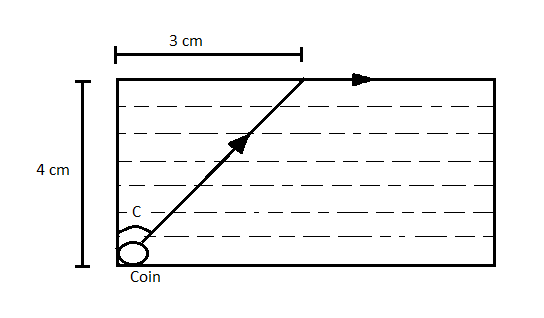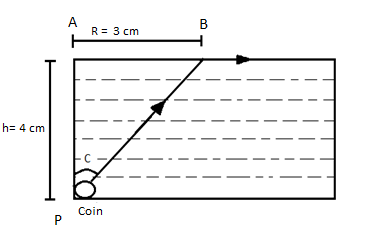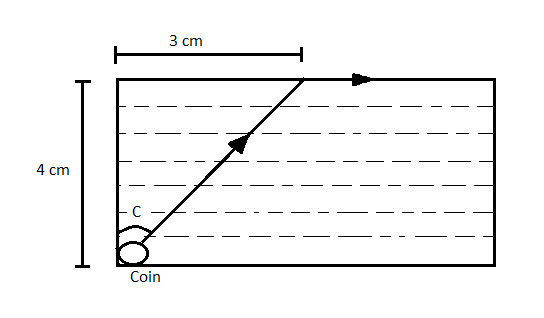
Answer
429.6k+ views
Hint: Here, the light ray did not emerge out from water (denser medium) to air (rarer medium) We can see from figure that, the angle of refraction is \[90{}^\circ \]. Then the incident angle is a critical angle. We can find out the velocity of light in water using the equation which relates the refractive index and sin of critical angle.
Formula used:
\[\text{sin C =}\dfrac{1}{\mu }\]
\[\mu =\dfrac{\text{Velocity of light in air}\left( c \right)}{\text{Velocity of light in liquid}\left( v \right)}\]
\[R=h\tan C\]
\[{{\sin }^{2}}a+{{\cos }^{2}}a=1\]
\[\text{sinC=}\dfrac{\text{adjacent side}}{\text{Hypotenuse}}\]
\[\tan C=\dfrac{\operatorname{sin}C}{\operatorname{Cos}C}\]
Complete answer:

As shown in the figure, the light ray from the coin did not emerge. Therefore, the angle of incidence is the critical angle.
(When the light travels from an optically denser medium to an optically less dense (rarer) medium, angle of incidence where the angle of refraction is \[90{}^\circ \] is known as critical angle.)
From the figure,
\[\text{sin C=}\dfrac{3}{\sqrt{{{4}^{2}}+{{3}^{2}}}}=\dfrac{3}{5}\]
Where, \[C\] is the critical angle
We know that,
\[\dfrac{1}{\mu }=\text{ sin C}\]
Where, \[\mu \] is the refractive index.
\[\text{sin C =}\dfrac{1}{\mu }\]
\[\mu =\dfrac{\text{Velocity of light in air}\left( c \right)}{\text{Velocity of light in liquid}\left( v \right)}\]
Therefore,
\[\sin C=\dfrac{v}{c}\]
We have, \[\text{c = 3}\times \text{1}{{\text{0}}^{8}}m/s\]
Then,
\[\sin C=\dfrac{v}{3\times {{10}^{8}}}\]
\[\dfrac{3}{5}=\dfrac{v}{3\times {{10}^{8}}}\]
\[v=\dfrac{3}{5}\times 3\times {{10}^{8}}=1.8\times {{10}^{8}}m/s\]
So, the correct answer is “Option B”.
Note:
This can be solved in another method.

Consider triangle PAB,
We have,
\[\dfrac{R}{h}=\tan C\]
Where,
\[\text{R - circle of radius}\]
\[\text{h- height}\]
\[R=h\tan C\]
\[R=h\times \dfrac{\sin C}{\operatorname{Cos}C}\]
Since, \[\left( {{\sin }^{2}}a+{{\cos }^{2}}a=1 \right)\]
\[R=h\times \dfrac{\sin C}{\sqrt{1-{{\sin }^{2}}C}}\]
We know that,
\[\text{sin C =}\dfrac{1}{\mu }\]
Then,
\[R=\dfrac{h}{\sqrt{{{\mu }^{2}}-1}}\]
\[\dfrac{3}{4}=\dfrac{h}{\sqrt{{{\mu }^{2}}-1}}\]
\[{{\mu }^{2}}=\dfrac{25}{9}\]
\[\mu =\dfrac{5}{3}=1.67\]
We know that,
\[\mu =\dfrac{c}{v}\]
\[v=\dfrac{3\times {{10}^{8}}}{1.66}=1.8\times {{10}^{8}}m/s\]
Formula used:
\[\text{sin C =}\dfrac{1}{\mu }\]
\[\mu =\dfrac{\text{Velocity of light in air}\left( c \right)}{\text{Velocity of light in liquid}\left( v \right)}\]
\[R=h\tan C\]
\[{{\sin }^{2}}a+{{\cos }^{2}}a=1\]
\[\text{sinC=}\dfrac{\text{adjacent side}}{\text{Hypotenuse}}\]
\[\tan C=\dfrac{\operatorname{sin}C}{\operatorname{Cos}C}\]
Complete answer:

As shown in the figure, the light ray from the coin did not emerge. Therefore, the angle of incidence is the critical angle.
(When the light travels from an optically denser medium to an optically less dense (rarer) medium, angle of incidence where the angle of refraction is \[90{}^\circ \] is known as critical angle.)
From the figure,
\[\text{sin C=}\dfrac{3}{\sqrt{{{4}^{2}}+{{3}^{2}}}}=\dfrac{3}{5}\]
Where, \[C\] is the critical angle
We know that,
\[\dfrac{1}{\mu }=\text{ sin C}\]
Where, \[\mu \] is the refractive index.
\[\text{sin C =}\dfrac{1}{\mu }\]
\[\mu =\dfrac{\text{Velocity of light in air}\left( c \right)}{\text{Velocity of light in liquid}\left( v \right)}\]
Therefore,
\[\sin C=\dfrac{v}{c}\]
We have, \[\text{c = 3}\times \text{1}{{\text{0}}^{8}}m/s\]
Then,
\[\sin C=\dfrac{v}{3\times {{10}^{8}}}\]
\[\dfrac{3}{5}=\dfrac{v}{3\times {{10}^{8}}}\]
\[v=\dfrac{3}{5}\times 3\times {{10}^{8}}=1.8\times {{10}^{8}}m/s\]
So, the correct answer is “Option B”.
Note:
This can be solved in another method.

Consider triangle PAB,
We have,
\[\dfrac{R}{h}=\tan C\]
Where,
\[\text{R - circle of radius}\]
\[\text{h- height}\]
\[R=h\tan C\]
\[R=h\times \dfrac{\sin C}{\operatorname{Cos}C}\]
Since, \[\left( {{\sin }^{2}}a+{{\cos }^{2}}a=1 \right)\]
\[R=h\times \dfrac{\sin C}{\sqrt{1-{{\sin }^{2}}C}}\]
We know that,
\[\text{sin C =}\dfrac{1}{\mu }\]
Then,
\[R=\dfrac{h}{\sqrt{{{\mu }^{2}}-1}}\]
\[\dfrac{3}{4}=\dfrac{h}{\sqrt{{{\mu }^{2}}-1}}\]
\[{{\mu }^{2}}=\dfrac{25}{9}\]
\[\mu =\dfrac{5}{3}=1.67\]
We know that,
\[\mu =\dfrac{c}{v}\]
\[v=\dfrac{3\times {{10}^{8}}}{1.66}=1.8\times {{10}^{8}}m/s\]
Recently Updated Pages
How many sigma and pi bonds are present in HCequiv class 11 chemistry CBSE

Mark and label the given geoinformation on the outline class 11 social science CBSE

When people say No pun intended what does that mea class 8 english CBSE

Name the states which share their boundary with Indias class 9 social science CBSE

Give an account of the Northern Plains of India class 9 social science CBSE

Change the following sentences into negative and interrogative class 10 english CBSE

Trending doubts
Differentiate between homogeneous and heterogeneous class 12 chemistry CBSE

Difference between Prokaryotic cell and Eukaryotic class 11 biology CBSE

Difference Between Plant Cell and Animal Cell

Fill the blanks with the suitable prepositions 1 The class 9 english CBSE

Which are the Top 10 Largest Countries of the World?

Give 10 examples for herbs , shrubs , climbers , creepers

10 examples of evaporation in daily life with explanations

The Equation xxx + 2 is Satisfied when x is Equal to Class 10 Maths

Why is there a time difference of about 5 hours between class 10 social science CBSE




